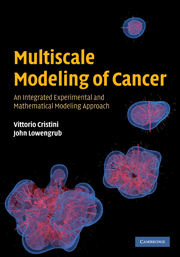Book contents
- Frontmatter
- Contents
- List of contributors
- Preface
- Acknowledgements
- Notation
- Part I Theory
- 1 Introduction
- 2 Biological background
- 3 Continuum tumor modeling: single phase
- 4 Analysis and calibration of single-phase continuum tumor models
- 5 Continuum tumor modeling: multiphase
- 6 Discrete cell modeling
- 7 Hybrid continuum–discrete tumor models
- 8 Numerical schemes
- Part II Applications
- References
- Index
6 - Discrete cell modeling
from Part I - Theory
Published online by Cambridge University Press: 05 October 2010
- Frontmatter
- Contents
- List of contributors
- Preface
- Acknowledgements
- Notation
- Part I Theory
- 1 Introduction
- 2 Biological background
- 3 Continuum tumor modeling: single phase
- 4 Analysis and calibration of single-phase continuum tumor models
- 5 Continuum tumor modeling: multiphase
- 6 Discrete cell modeling
- 7 Hybrid continuum–discrete tumor models
- 8 Numerical schemes
- Part II Applications
- References
- Index
Summary
In this chapter, we introduce discrete cancer-cell modeling, assess the strengths and weaknesses of the available discrete cell modeling approaches, sample the major discrete cell modeling approaches employed in current computational cancer modeling, and introduce a discrete agent-based cell modeling framework. This framework currently being developed by the present authors and collaborators will be used to implement the next-generation multiscale cancer-modeling framework detailed in Chapter 7.
A brief review of discrete modeling in cancer biology
Thus far we have discussed continuum modeling, in which cancer is modeled at the tissue scale and the effects of individual cells are averaged out. We now turn our attention to discrete models, in which the behavior of one or more individual cells as they interact with one another and the microenvironment is addressed.
Discrete modeling has enjoyed a long history in applied mathematics and biology, dating as far back as the 1940s when John von Neumann applied lattice crystal models to study the necessary rule sets for self-replicating robots. Perhaps the most famous early example of discrete biological modeling is John Conway's 1970 “game of life,” a two-dimensional rectangular lattice of “cells” that changed color according to rules based upon the colors of the neighboring cells. Even simple rules can lead to complex emergent behavior, and Conway's model was later shown to be Turing complete. Today, discrete cell modeling has advanced to study a broad swath of cancer biology, spanning carcinogenesis, tumor growth, invasion, and angiogenesis.
- Type
- Chapter
- Information
- Multiscale Modeling of CancerAn Integrated Experimental and Mathematical Modeling Approach, pp. 88 - 122Publisher: Cambridge University PressPrint publication year: 2010
- 13
- Cited by



